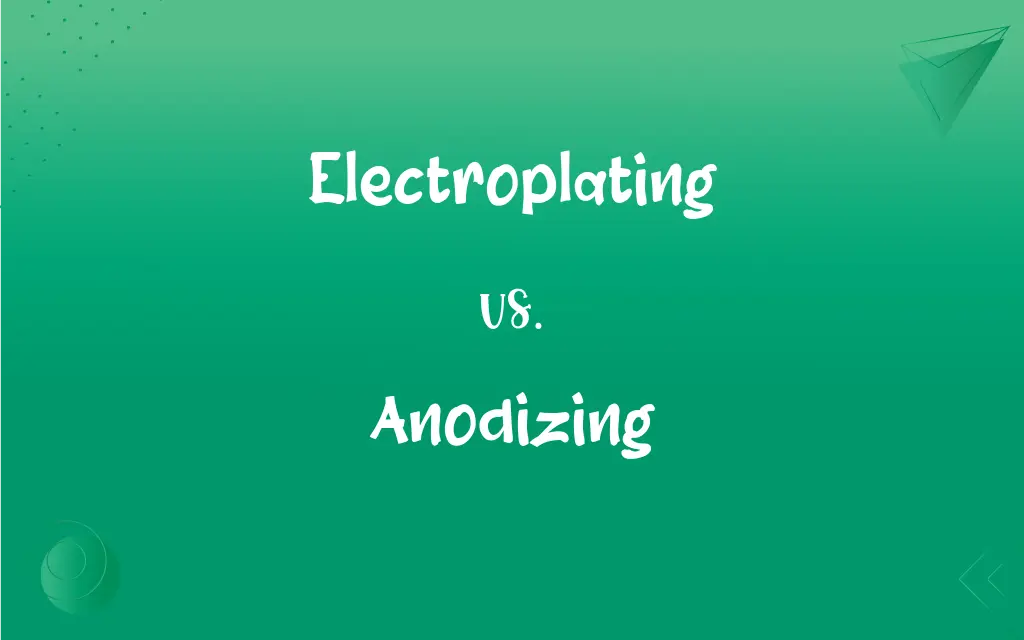Electroplating vs. Anodizing: What's the Difference?
Edited by Harlon Moss || By Janet White || Published on December 18, 2023
Electroplating adds a metal layer using electric current, while anodizing thickens a metal's oxide layer using an electrolytic process.

Key Differences
Electroplating involves depositing a metal layer on an object via an electrical current, which attracts metal ions to the surface. Anodizing, in contrast, uses an electrochemical process to form a protective or decorative oxide layer on a metal surface.
The primary purpose of electroplating is to improve corrosion resistance, enhance appearance, or increase thickness. Anodizing also aims to enhance corrosion resistance, but it uniquely alters the surface structure of metals like aluminum for better wear resistance.
In electroplating, various metals like gold, silver, or nickel can be used for coating. Anodizing is mostly limited to specific metals like aluminum, where the oxide layer is integral to the metal itself.
The process of electroplating can be controlled to achieve varying thicknesses and finishes. Anodizing offers a range of colors through dyeing the porous oxide layer, providing both aesthetic and functional benefits.
Electroplating is often chosen for its versatility in applications across different industries. Anodizing, however, is particularly favored in aerospace and automotive sectors for its durability and lightweight characteristics.
ADVERTISEMENT
Comparison Chart
Process
Uses electric current to deposit metal ions.
Electrochemical process to grow an oxide layer.
Metals Used
Versatile, used with many metals.
Primarily aluminum and titanium.
Purpose
Enhance appearance, corrosion resistance.
Improve corrosion resistance, wear resistance.
Finish Variety
Various metal finishes.
Color through dyeing, more limited finishes.
Industry Applications
Broad, including electronics, automotive.
Often in aerospace, automotive for light weight.
ADVERTISEMENT
Electroplating and Anodizing Definitions
Electroplating
Electroplating is the process of coating an object with a thin layer of metal using electrical current.
Electroplating is used to coat car parts with chrome for enhanced durability and shine.
Anodizing
Anodizing is an electrolytic process that forms a durable oxide layer on metals.
Anodizing aluminum bike frames improves their resistance to scratches.
Electroplating
Electroplating can enhance electrical conductivity by adding a conductive layer.
Electronic components are often electroplated with gold for better conductivity.
Anodizing
Anodizing allows for coloration of metals through dye absorption.
Anodized aluminum sheets are used in art installations for their vibrant colors.
Electroplating
It is used to increase surface hardness and wear resistance through a metallic coating.
Industrial tools are electroplated with nickel for improved longevity.
Anodizing
It enhances corrosion resistance and surface hardness of metals.
Anodizing is commonly used in marine hardware for its corrosion resistance.
Electroplating
Electroplating serves decorative purposes, adding aesthetic value to objects.
Jewelry is often electroplated with silver or gold for a luxurious finish.
Anodizing
The process creates a porous surface that can hold lubricants, aiding in maintenance.
Anodizing is used in automotive parts to retain lubrication.
Electroplating
It's a technique to apply a metal coating on a conductive surface to prevent corrosion.
Electroplating copper onto steel pipes prevents rusting.
Anodizing
Anodizing is environmentally friendly, producing a non-toxic and heat-resistant coating.
Cookware is often anodized to ensure a non-toxic, heat-resistant surface.
Electroplating
To coat or cover with a thin layer of metal by electrodeposition.
Anodizing
To coat (a metallic surface) electrolytically with a protective or decorative oxide.
Electroplating
Present participle of electroplate
Anodizing
Present participle of anodize
Electroplating
A process of coating the surfaces of a metal object with a layer of a different metal through electrochemical means, usually to exploit different properties of the materials.
Electroplating
The art or process of depositing a coating (commonly) of silver, gold, or nickel on an inferior metal, by means of an electric current. The metal to be deposited on an article is usually used as the anode and the article to be plated as the cathode, in an electrolyte solution in which the plating metal is the cation. The process is conducted in a tank called an electroplating bath, which holds the electrolyte solution.
FAQs
Which metals are suitable for anodizing?
Anodizing is typically used for aluminum, titanium, and magnesium.
What is anodizing?
Anodizing is an electrolytic process that increases the thickness of the natural oxide layer on the surface of metal parts.
Which metals can be electroplated?
Electroplating can be applied to a wide range of metals, including copper, nickel, silver, and gold.
How does electroplating improve an object?
It improves corrosion resistance, electrical conductivity, and aesthetic appeal.
Can electroplating be used for decorative purposes?
Yes, electroplating is often used for decorative purposes, especially in jewelry and automotive.
Are anodized surfaces scratch-resistant?
Yes, anodized surfaces are more resistant to scratches and wear.
Does anodizing fade over time?
Anodized colors can fade if exposed to UV light for extended periods.
What is electroplating?
Electroplating is a process of coating an object with a metal layer using an electric current.
What are the benefits of anodizing?
Anodizing enhances corrosion and wear resistance, and can also add color.
How is anodizing maintained?
Anodized surfaces require minimal maintenance, often just cleaning with soap and water.
How environmentally friendly is anodizing?
Anodizing is relatively environmentally friendly as it uses fewer harmful chemicals.
Does the thickness of an anodized layer matter?
Yes, thicker anodized layers offer better protection and durability.
Can electroplated surfaces be repaired?
Yes, electroplated surfaces can be re-plated if damaged or worn.
What is the cost difference between electroplating and anodizing?
Generally, anodizing is less expensive than electroplating, but costs can vary based on the project.
Can any color be achieved with anodizing?
Anodizing offers a range of colors, but there are limitations compared to dyes and paints.
Are anodized materials safe for cooking?
Yes, anodized aluminum is widely used in cookware due to its non-toxic and heat-resistant properties.
Is electroplating environmentally friendly?
Electroplating can involve toxic chemicals, so it requires careful environmental management.
How long does electroplating last?
The durability of electroplating depends on the thickness and type of metal used.
How does thickness affect electroplating?
Thicker electroplating provides better corrosion resistance but can be more expensive.
Is electroplating suitable for food-grade materials?
Certain types of electroplating, like nickel and gold, are suitable for food-grade applications.
About Author
Written by
Janet WhiteJanet White has been an esteemed writer and blogger for Difference Wiki. Holding a Master's degree in Science and Medical Journalism from the prestigious Boston University, she has consistently demonstrated her expertise and passion for her field. When she's not immersed in her work, Janet relishes her time exercising, delving into a good book, and cherishing moments with friends and family.
Edited by
Harlon MossHarlon is a seasoned quality moderator and accomplished content writer for Difference Wiki. An alumnus of the prestigious University of California, he earned his degree in Computer Science. Leveraging his academic background, Harlon brings a meticulous and informed perspective to his work, ensuring content accuracy and excellence.






































































